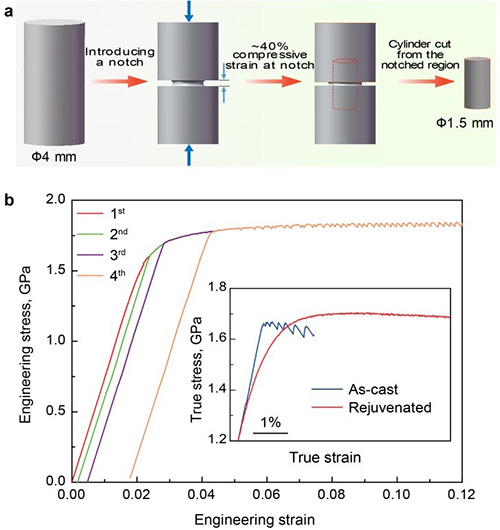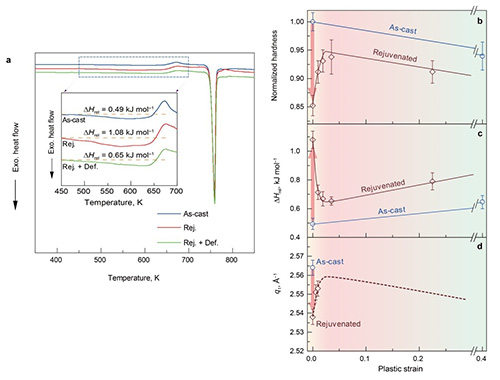Strain Hardening in Metallic Glasses
Strain-hardening (the increase of flow stress with plastic strain) is the most important phenomenon in the mechanical behaviour of engineering alloys because it ensures that flow is delocalized, enhances tensile ductility and inhibits catastrophic mechanical failure. Metallic glasses (MGs) lack the crystallinity of conventional engineering alloys, and some of their properties-such as higher yield stress and elastic strain limit-are greatly improved relative to their crystalline counterparts. MGs can have high fracture toughness and have the highest known'damage tolerance'(defined as the product of yield stress and fracture toughness) among all structural materials. However, the use of MGs in structural applications is largely limited by the fact that they show strain-softening instead of strain-hardening; this leads to extreme localization of plastic flow in shear bands, and is associated with early catastrophic failure in tension.
Collaboration research between Prof. Yi Li's group at the Shenyang National Laboratory of Materials Science, Institute of Metal Research, Chinese Academy of Sciences (IMR, CAS), and Prof. A.L. Greer's group at Cambridge University, UK, shows that plastic deformation under triaxial compression at room temperature can rejuvenate bulk MG samples sufficiently toenablestrain-hardening through a mechanism that has not been previously observed in the metallic state (DOI: 10.1038/s41586-020-2016-3).
Compared with the as-cast bulk metallic glass, the highly rejuvenated bulk metallic glass shows significantly reduced yield stress, obvious work-hardening and excellent plastic deformation capacity under deformation. Within strain-hardening (a process of homogeneous flow), there would be no cause for shear-banding on the sample surfaces, totally different from traditional metallic glass deforming by shear-banding. As the plastic deformation continues, the hardness increases, accompanying with reduced exothermic heat of relaxation and densification, indicating that strain-hardening is closely related with structure relaxation. Simultaneously, the structural changes indicated by the position of the first haloq1, which shifts back towards higherqby deforming a rejuvenated sample, correlate well with the changes in the exothermic heat of relaxation and hardness, supporting the link between strain-hardening and structural relaxation. In addition, the initial rates of hardening are much higher than those of crystalline alloys, showing a very efficient hardening mechanism. However, the hardening capacity is soon exhausted.
Work-hardening in crystalline metals is mediated by dislocations (defects), which proliferate and increasingly impede each other's glide under deformation; it is based on an increase in energy, which was proposed by G. I. Taylor eighty-five years ago. However, for bulk metallic glass, the work-hardening is based on a reduction in energy (a transformation from high energy state to low energy state, reducing the defect density), which is opposite with that in crystalline metals, indicating a novel mechanism inducing strain-hardening in the metallic glass. The rejuvenated MGs are stable at room temperature and show exceptionally efficient strain-hardening, greatly increasing their potential use in structural applications.
This work is supported by the National Natural Science Foundation of China, Shenyang National Laboratory of Materials Science, and Institute of Metal Research, Chinese Academy of Sciences.
Links:https://www.nature.com/articles/s41586-020-2016-3

a, A 4-mm-diameter rod of Zr64.13Cu15.75Ni10.12Al10 bulk MG is machined to have a circumferential notch. Uniaxial compression induces plastic deformation, reducing the notch width by 40%. This processing produces a highly rejuvenated region within the notched rod, from which a 1.5-mm-diameter, 3-mm-long glass cylinder is machined. b, Four engineering stress-strain curves for uniaxial compression, corresponding to three unloading-reloading cycles of one sample rejuvenated as in a. Inset, comparison of true stress-true strain curves of a rejuvenated sample and a 2-mm-diameter as-cast rod of the same composition. The rejuvenated glass shows extensive homogeneous flow (without serrations) and strain-hardening (manifest in the characteristic unloading-reloading curves).

a, Differential scanning calorimetry traces measured on heating of Zr64.13Cu15.75Ni10.12Al10 MG samples at 20 K min-1: as-cast (blue), rejuvenated (red), and rejuvenated and then deformed under uniaxial compression to selected strains (green). The inset shows a close-up of the relaxation exotherm and the glass transition. The dashed horizontal lines in the inset show the baseline with respect to which the heat of relaxation Hrel is measured. Details about the samples are provided in Extended Data Table 3. b-d, Normalized microhardness Hv/Hvas-cast (where Hvas-cast = 495 kgf mm?2) (b), heat of relaxation Hrel (c), and the position of the main diffraction halo q1 (d; see Fig. 4b) of rejuvenated samples (diamonds) as a function of the compressive plastic strain applied. The arrows show the property changes induced by the prior rejuvenation. Values of as-cast samples (circles; from ref. 13) are shown for comparison. The error bars show the standard deviation for the measurements.